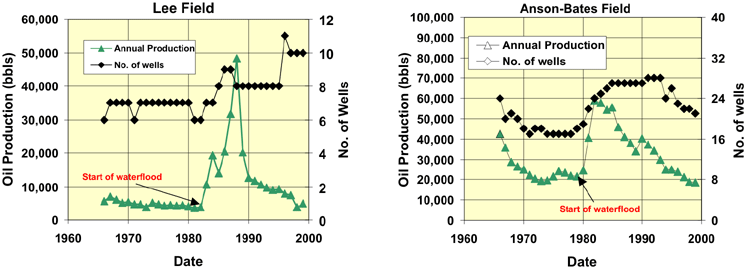 |
|
Kansas Geological Survey Open-file Report 2003-31 |
Results of Successful Waterfloods in Neighboring Fields
Data available from two Missisissippian fields show remarkable incremental production during planned secondary recovery. The Lee field, Sumner County, Kansas, is similar in size and number of wells as the Wellington West field. Detailed studies were carried out on this field to design an effective waterflood. At the onset of the waterflood, the annual field production was close to 3,880 BO. Upon full implementation of the waterflood, peak production rose to 48,000 BO/year, and currently, 10 years after the onset of the flood, this field continues to produce at a higher rate (4,200 BO/year) higher than the pre-flood production (Figure). Cumulative production from the Lee field before the onset of the waterflood was 263.2 Mstb. Additional incremental oil from waterflooding is estimated to be 255.2 Mstb. The Lee field demonstrates the immense potential that properly designed and implemented waterfloods have in recovering the significant resources left behind after primary production in Mississippian carbonate fields.
The Anson field, Sumner County, Kansas, is another example of a successful waterflood in a Mississippian dolomitic reservoir. The operator of this field employed a consulting firm to characterize the reservoir and design an effective waterflood. The preflood annual field production was 24,500 bbls. After the implementation of the flood, the annual field production peaked close to 9,400m3 (59,000 bbls), and currently, after 17 years since the inception of the flood, the field produces at 18,000 bbls/year. The Anson field is slightly bigger in size than the Wellington West field with the number of operating wells during the waterflood varying between 21 and 28. The waterflood in the Anson field resulted in a cumulative production of 740 Mstb while the pre-flood cumulative production was 1,450 Mstb.

|
|
Last updated July 2003
http://www.kgs.ku.edu/PRS/publication/2003/ofr2003-31/P1-06.html
